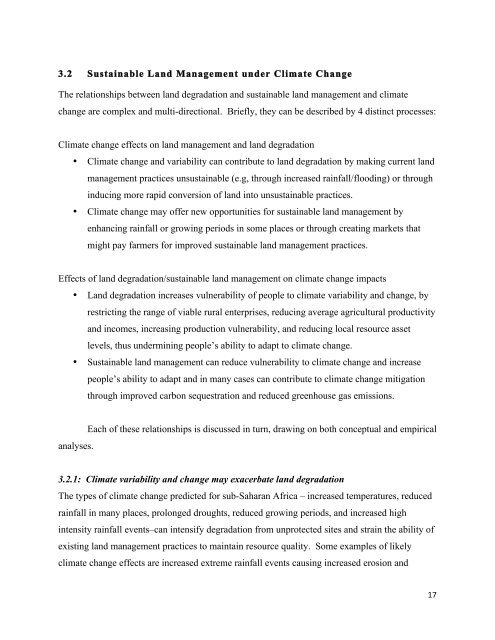The Role of Sustainable Land Management for Climate ... - CAADP
The Role of Sustainable Land Management for Climate ... - CAADP
The Role of Sustainable Land Management for Climate ... - CAADP
Create successful ePaper yourself
Turn your PDF publications into a flip-book with our unique Google optimized e-Paper software.
!<br />
3.2 <strong>Sustainable</strong> <strong>Land</strong> <strong>Management</strong> under <strong>Climate</strong> Change<br />
<strong>The</strong> relationships between land degradation and sustainable land management and climate<br />
change are complex and multi-directional. Briefly, they can be described by 4 distinct processes:<br />
<strong>Climate</strong> change effects on land management and land degradation<br />
• <strong>Climate</strong> change and variability can contribute to land degradation by making current land<br />
management practices unsustainable (e.g, through increased rainfall/flooding) or through<br />
inducing more rapid conversion <strong>of</strong> land into unsustainable practices.<br />
• <strong>Climate</strong> change may <strong>of</strong>fer new opportunities <strong>for</strong> sustainable land management by<br />
enhancing rainfall or growing periods in some places or through creating markets that<br />
might pay farmers <strong>for</strong> improved sustainable land management practices.<br />
Effects <strong>of</strong> land degradation/sustainable land management on climate change impacts<br />
• <strong>Land</strong> degradation increases vulnerability <strong>of</strong> people to climate variability and change, by<br />
restricting the range <strong>of</strong> viable rural enterprises, reducing average agricultural productivity<br />
and incomes, increasing production vulnerability, and reducing local resource asset<br />
levels, thus undermining people’s ability to adapt to climate change.<br />
• <strong>Sustainable</strong> land management can reduce vulnerability to climate change and increase<br />
people’s ability to adapt and in many cases can contribute to climate change mitigation<br />
through improved carbon sequestration and reduced greenhouse gas emissions.<br />
analyses.<br />
Each <strong>of</strong> these relationships is discussed in turn, drawing on both conceptual and empirical<br />
3.2.1: <strong>Climate</strong> variability and change may exacerbate land degradation<br />
<strong>The</strong> types <strong>of</strong> climate change predicted <strong>for</strong> sub-Saharan Africa – increased temperatures, reduced<br />
rainfall in many places, prolonged droughts, reduced growing periods, and increased high<br />
intensity rainfall events–can intensify degradation from unprotected sites and strain the ability <strong>of</strong><br />
existing land management practices to maintain resource quality. Some examples <strong>of</strong> likely<br />
climate change effects are increased extreme rainfall events causing increased erosion and<br />
!<br />
$*!

















